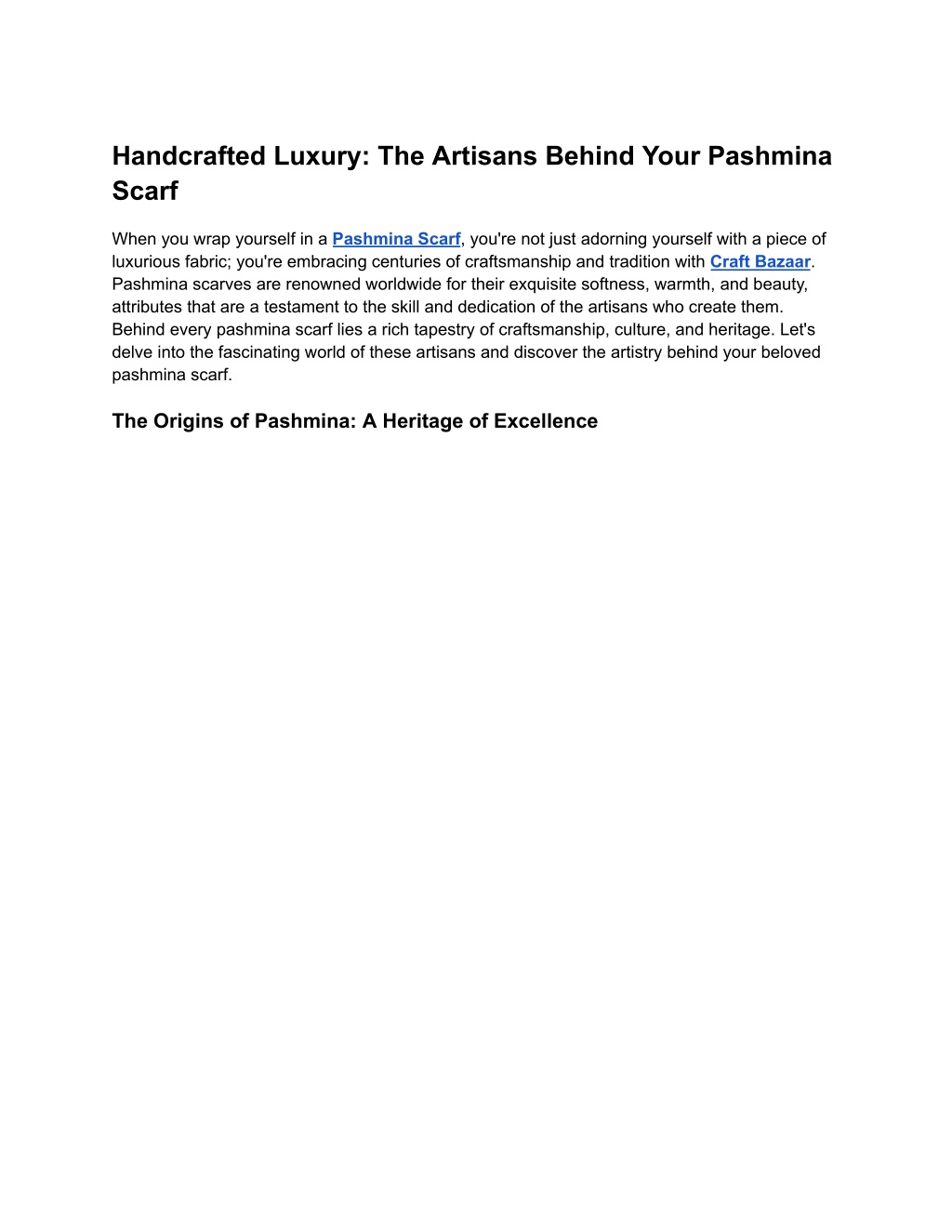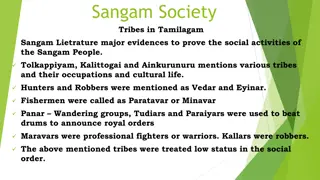
Handcrafted Luxury_ The Artisans Behind Your Pashmina Scarf
Handcrafted Luxury_ The Artisans Behind Your Pashmina Scarf
Download Presentation

Please find below an Image/Link to download the presentation.
The content on the website is provided AS IS for your information and personal use only. It may not be sold, licensed, or shared on other websites without obtaining consent from the author. Download presentation by click this link. If you encounter any issues during the download, it is possible that the publisher has removed the file from their server.
E N D
Presentation Transcript
Handcrafted Luxury: The Artisans Behind Your Pashmina Scarf When you wrap yourself in a Pashmina Scarf, you're not just adorning yourself with a piece of luxurious fabric; you're embracing centuries of craftsmanship and tradition with Craft Bazaar. Pashmina scarves are renowned worldwide for their exquisite softness, warmth, and beauty, attributes that are a testament to the skill and dedication of the artisans who create them. Behind every pashmina scarf lies a rich tapestry of craftsmanship, culture, and heritage. Let's delve into the fascinating world of these artisans and discover the artistry behind your beloved pashmina scarf. The Origins of Pashmina: A Heritage of Excellence
Pashmina wool, often referred to as "soft gold," comes from the Changthangi goats, native to the high-altitude regions of the Himalayas. These goats produce a fine undercoat of wool that is incredibly soft and lightweight, making it ideal for weaving into luxurious scarves and shawls. The art of weaving pashmina dates back over 500 years, with Kashmir in India being the epicenter of this exquisite craftsmanship. The Artisans: Masters of Their Craft
At the heart of every pashmina scarf is the skilled artisan who transforms raw pashmina wool into a work of art. These artisans, often following family traditions passed down through generations, undergo years of rigorous training to perfect their craft. They possess an innate understanding of the delicate pashmina fibers and the intricate techniques required to weave them into fine scarves. Skillful Techniques: 1. Spinning: The process begins with hand-spinning the raw pashmina fibers into yarn, a meticulous task that requires precision and expertise. The yarn is then carefully dyed using natural or synthetic dyes to achieve vibrant or subtle colors.
2. Weaving: The weaving of pashmina scarves is predominantly done on traditional handlooms. Each scarf is woven with precision, with the artisan meticulously interlacing each thread to create intricate patterns or designs. The weaving process can take several days to weeks, depending on the complexity and size of the scarf. 3. Embroidery and Finishing: Many pashmina scarves feature exquisite embroidery, often done by hand using fine needles and silk threads. This embellishment adds an extra layer of artistry and elegance to the scarf. Once woven and embroidered, the scarf undergoes careful finishing, including washing, blocking, and pressing, to achieve its final luxurious texture and drape. Preserving Tradition: Sustainability and Ethical Practices
In recent years, there has been a growing emphasis on preserving the traditional craftsmanship of pashmina while ensuring ethical and sustainable practices. Artisan cooperatives and organizations work to empower local artisans, providing fair wages, safe working conditions, and opportunities for skills development. By supporting these ethical practices, consumers contribute to the preservation of cultural heritage and sustainable livelihoods within the communities where pashmina is produced. Celebrating Diversity: Regional Variations and Styles While Kashmir remains synonymous with pashmina craftsmanship, other regions in India, Nepal, and even parts of Mongolia have also embraced this art form. Each region brings its unique style and flair to pashmina scarves, showcasing diverse weaving techniques, patterns,
and motifs. Whether it's the intricate paisley patterns of Kashmiri shawls or the bold geometric designs of Nepalese scarves, each piece reflects the cultural richness and creativity of its artisans. Pashmina in the Modern World: Adapting to Global Trends In today's globalized world, pashmina scarves have transcended cultural boundaries and become a symbol of timeless luxury and sophistication. They are cherished by fashion enthusiasts and celebrities alike for their unparalleled quality and versatility. Modern trends have seen pashmina scarves being incorporated into everyday fashion, from casual streetwear to high-end couture, showcasing their adaptability and enduring appeal.
Caring for Your Pashmina Scarf: Maintaining Its Beauty To ensure your pashmina scarf retains its beauty and longevity, proper care is essential: Storage: Store your pashmina scarf in a breathable fabric bag or a clean, dry place to protect it from dust and moths. Cleaning: Hand wash your scarf in cold water using a mild detergent or baby shampoo. Avoid twisting or wringing the fabric; instead, gently squeeze out excess water and lay it flat to dry. Avoiding Snags: Handle your pashmina scarf with care, as it is susceptible to snags and pulls. Avoid wearing jewelry or sharp accessories that could catch on the delicate fibers.
















































